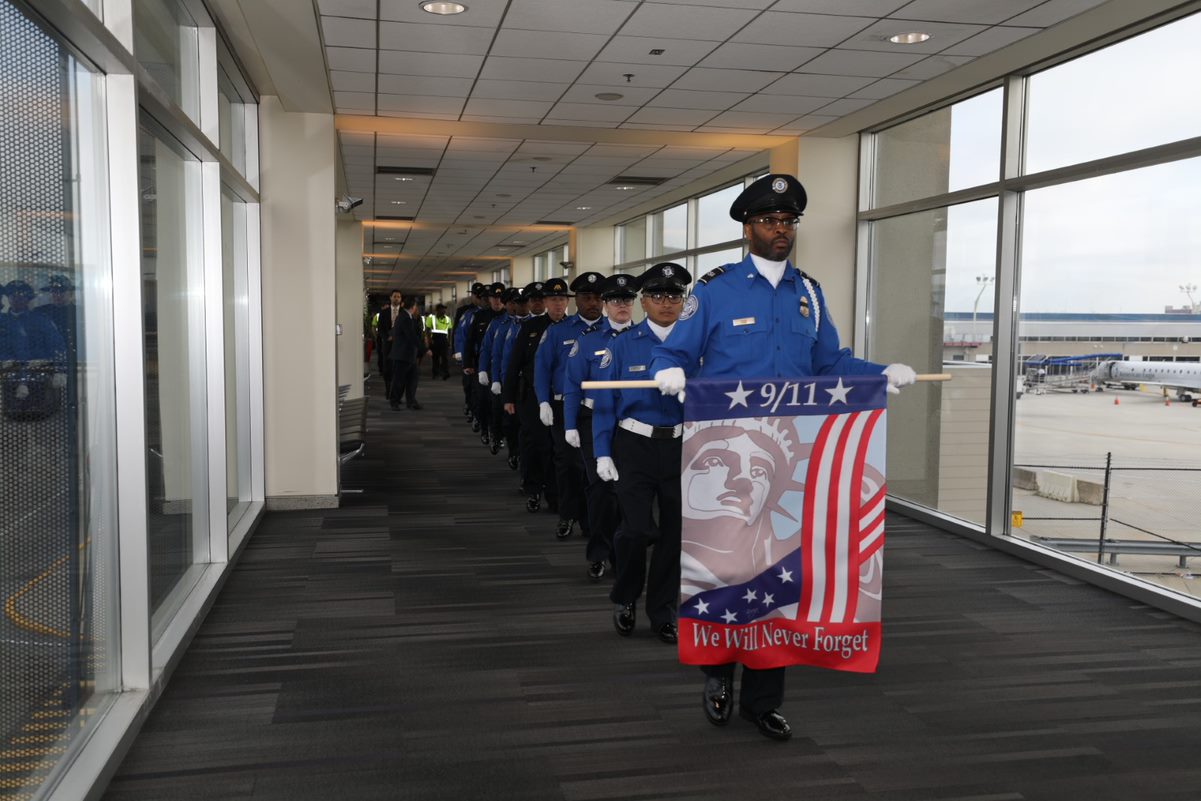On September 10, 2001, anyone – even those who weren’t flying out – could come to the airport and pass through the security checkpoint to enter the secure area. At the checkpoint, screeners employed by private companies hired by the airlines scanned carry-on bags. Anyone passing through the checkpoint could do so without taking off shoes, belts, and outerwear or removing items from their carry-ons. Liquids, gels and aerosols in any quantity could be brought through the checkpoint. Unless something set off the metal detector that could require extra screening, going through security in an airport was a relatively benign, routine exercise – on and up until September 10, 2001.
On the morning of September 11, 2001, 19 terrorists boarded four commercial flights – two in Boston, one in Newark, N.J. and one in Washington, DC – and hijacked them shortly after take-off. American Airlines Flight 11 and United Airlines Flight 175, both flying from Boston to Los Angeles, crashed into the World Trade Center in New York City. American Airlines Flight 77 flying from Washington, DC to Los Angeles crashed into the Pentagon. United Airlines Flight 93 flying from Newark to San Francisco crashed into the ground in Shanksville, Pennsylvania. The deadliest terrorist attack on American soil claimed the lives of nearly 3,000 people.
In the aftermath of September 11, an intense spotlight was focused on airport security and measures were put in place aimed at preventing similar attacks from happening again. Among the new regulations, only passengers with tickets to fly that day would be allowed past the security checkpoint. Sharp items would be banned from carry-on bags. Vehicles could pull up curb side only for active loading and unloading.
On November 19, 2001, the Aviation and Transportation Security Act was passed by the 107th Congress and signed into law by President George W. Bush. The Act established the Transportation Security Administration requiring screening conducted by federal officials, 100 percent checked baggage screening, expansion of the Federal Air Marshal Service and reinforced cockpit doors. In addition to airports, TSA was created to oversee security in all modes of transportation.
“The TSA was created in direct response to the tragic events of September 11, 2001 to prevent such another horrendous act from happening again. In these last 20 years, the TSA has been a valued partner with PHL and all airports in keeping our guests, employees and business associates safe,” said PHL Airport CEO Chellie Cameron. “We thank the TSA for their diligence and commitment in continuing to safeguard the aviation community through innovation and practices, and we look forward to continuing our collaboration with this important agency and its dedicated workforce in keeping PHL safe.”

“As we approach the 20th anniversary of that unprecedented attack, we must never forget the events of 9-11,” said Gerardo Spero, Federal Security Director at PHL. “We’ve all worked tirelessly for two decades because the memory of that day compels us to do everything we can do to ensure it never happens again. I am proud to be a part of an organization that was created specifically for that purpose and has done so much to ensure the security of hundreds of millions of travelers.”
In the ensuing months, years and decades, incidents in the air and on the ground would result in more measures to tighten security at airports.
Here is a closer look at how the TSA has grown and evolved since its creation in November 2001.
December 2002: TSA meets a key mandate of the Aviation and Transportation Security Act by deploying explosives detection systems nationwide to screen all bags for explosives.
April 2003: The federal flight deck officer program is created in response to the Arming Pilots Against Terrorism Act signed into law in November 2002. TSA begins training flight-deck personnel to carry firearms in early 2003 and the first armed pilots are aboard commercial flights by April.
April 2003: In accordance with ATSA and a January 2002 mandate, TSA works with the FAA and air carriers to reinforce cockpits doors on commercial aircraft in order to protect from intrusion, small-arms fire and fragmentation devices such as grenades. By April 2003, all air carriers meet the requirement.
August 2006: Based on intelligence pointing to a continuing threat, TSA requires passengers to remove shoes to screen for explosives.
August 2006: In addition to new security measures, TSA also deploys federal air marshals overseas to counter the evolving threat to aviation security.
September 2006: TSA enhances security measures to include more random screening of employees, additional canine patrols, stronger air cargo security measures, more rigorous identity verification standards and deploying more trained security officers in bomb appraisal and screening by observation techniques.
September 2006: A month after the implementation of the original liquids ban, TSA amends its rules governing liquids in passenger carry-on baggage and allows airline passengers to carry liquids, gels and aerosols in containers of only 3.4 ounces or less in a single, clear, resealable 1-quart plastic bag.
March 2008: TSA deploys proprietary canine teams to aid in the screening of 100 percent air cargo loaded on U.S. passenger aircraft. TSA later expands the program to include passenger and baggage screening at airports.
March 2010: TSA begins formally installing hundreds of advanced imaging technology units at U.S. airports. These units, also known as “full-body scanners,” are designed to detect non-metallic weapons explosives and other threats, which could be concealed under layers of clothing and may evade traditional metal detectors. By the end of 2010, approximately 500 AIT machines are deployed nationwide.
June 2010: TSA achieves 100 percent pre-screening for all covered domestic air carrier flights within, in-bound for, or out-bound from the United States using the Secure Flight system.
November 2010: Passengers are prohibited from having printer cartridges in carry-on baggage as the result of an incident the previous month in which authorities intercepted two IEDs concealed in printer cartridges that they determined were to detonate on flights to the U.S.
December 2011: TSA begins TSA PreCheck® operations at McCarran International Airport in Las Vegas. TSA PreCheck® is an expedited screening program that makes risk assessments about passengers prior to their arrival at an airport checkpoint. It provides expedited screening for known and trusted travelers at security checkpoints.
December 2013: The first TSA PreCheck® application center opens at Indianapolis International Airport. U.S. citizens and lawful permanent residents can apply for TSA PreCheck® by providing biographic information, fingerprints, payment, and identity and citizenship/immigration documentation.
December 2014: TSA makes numerous operation enhancements to advanced imaging technology and explosives trace detection, to complement technologies already in use. TSA focuses on improved pat-down procedures for alarm resolution and specialized screening requirement for select passengers at a number of international and domestic airports.
February 2015: TSA utilizes testing teams to identify areas and means of improving detection and resolution capabilities. TSA requires enhanced screening at select overseas airports with direct flights to the United States and increases the number of random searches of passengers and carry-on luggage boarding aircraft at U.S. airports.
May 2016: TSA, in collaboration with industry partners, begins deploying state-of-the-art automated screening lanes. Security enhancement features include unique radio frequency identification tags attached to bin to allow for additional accountability of items and cameras that capture photos of the outside of the bag that are linked to the X-ray images of the bag’s contents.
July 2017: To ensure the security of airline passengers and U.S. airports, TSA begins implementing new, stronger domestic screening procedures for carry-on items that require travelers to place all personal electronics larger than a cell phone in bins for X-ray screening in standard lanes.
February 2018: TSA and Los Angeles World Airports partnered to demonstrate two security checkpoint technologies that were piloted at Los Angeles International Airport. U. S. Customs and Border Patrol was a partner in the pilot program that used facial recognition technology to automate the identification and boarding pass verification process. The second pilot project featured an enhanced Advanced Imaging Technology (eAIT) unit with increased detection capabilities.
July 2018: TSA announced plans to test CT scanners, a state-of-the-art, 3-D technology at select U.S. airport checkpoints. The new technology enhances critical explosives and other threat-item detection capabilities at airport checkpoints. The system applies sophisticated algorithms for the detection of explosives and creates a 3-D image that can be viewed and rotated on three axes for thorough, visual, image analysis by a TSA officer. The CT scanners were put in place at PHL in 2020.
October 2018: The FAA Reauthorization Act of 2018, Public Law 115-254, was signed, which included the TSA Modernization Act, and marked the first ever reauthorization of TSA since the agency’s founding in 2001. The bill authorized TSA to continue as an agile and modern national security organization, capable of dealing with ever-evolving threats to the transportation system. The reauthorization act empowered TSA to expand field operations testing of advanced screening technologies, increased the use of canine resources, and enhanced public area security. It will also improve passenger and cargo security, cockpit and cabin security, surface transportation security, and foreign airport security.
December 2018: In partnership with TSA, Denver International Airport is the first U.S. airport to operate next generation Enhanced Advanced Imaging Technology (eAIT) for checkpoint security screening. The equipment has enhanced detection capabilities that improve security and may help improve the passenger experience.
March 2020: Due to the COVID-19 pandemic, TSA announced that one liquid hand sanitizer container up to 12 ounces per passenger, is allowed in carry-on bags until further notice.
2020: TSA installs touchless automated photo identification scanners at airports. Credential Authentication Technology (CAT) arrived at PHL in summer 2020.






